Uncategorized
This Israeli village on the Lebanon border was isolated for decades. Now it’s a tourist hotspot.
GHAJAR, Israel (JTA) – A group of 40 tourists filed into Khateb Sweets on a recent Sunday afternoon, bringing chatter — and their cash and credit cards — to what had been a quiet cafe in this equally sedate village in the Golan Heights.
They left after consuming pastries and hot tea spiced with ginger, anise and cinnamon, whereupon an Israeli Jewish couple came in, then an Israeli Arab family and three Canadians.
The steady foot traffic typifies the wave of tourists that since last fall has hit this community of 2,900 people, nearly all Alawites, an Islamic sect.
Ghajar (pronounced RA-zhar) had for decades been unusually cut off from the rest of Israel. Residents could come and go, but outsiders could visit only through prior arrangement with the Israel Defense Forces, which considered the village within a closed military area where Lebanon and Israel’s Galilee and Golan Heights regions intersect.
The IDF’s lifting of the restriction without explanation on Sept. 8 led to an immediate rush of visitors eager to explore Ghajar.
How immediate? Ahmad Khateb, a pastry chef who owns the eponymous cafe, was working that day at his consultancy job at a hotel in the Galilee town of Tzfat, when his employee called to report an unusual stream of tourists entering the shop. The following morning, Khateb resigned to work at his café full time.
People enjoy a food truck in a plaza in Ghajar, Oct. 14, 2022. (Yossi Aloni/Flash90)
Approximately 4,000 people visited Ghajar the day the town opened, he said. Another 6,000 visited the following day — briefly tripling the number of people in town. For day three, a Saturday, Ghajar turned a soccer field into a parking lot.
“It’s like a gift that fell from the sky,” Khateb said of the village’s opening and his subsequent increase in sales. He’s now considering expansion to other locations.
Ghajar possesses a Forbidden City-like attraction for Israelis, who travel extensively inside their own country because it requires a flight to visit others.
“You know why we came here? Because there aren’t a lot of places [in Israel] we haven’t been,” said Shmuel Browns, a Jerusalem-based tour guide accompanying his brother and sister-in-law visiting from his native Toronto. “We wanted to get a sense of what makes this village unique.”
It is also notable as the only Israeli community of Alawites, a Syria-based ethnic minority best known as the group that the country’s dictatorial rulers for the past 52 years — current president Bashar al-Assad and his late father, Hafez — are descended from. Bilal Khatib, who is Ghajar’s accountant and spokesman, said Alawites tend to be secular people who value a person’s character and are respectful of other Muslim sects and different religions. Ghajar contains no mosques, since, except on holy days, people pray individually at home.
People gather in front of a shop in Ghajar, Oct. 14, 2022. (Yossi Aloni/Flash90)
“It’s a way of life,” Khatib said. “We respect people as people. Our religion is to be a good person, love everyone and hold no hatred against anyone, be they Druze, Jew, Christian or Circassian.”
But most unusual is Ghajar’s provenance, on which outsiders tend to stumble. “Ghajar was part of Lebanon, right?” the Israeli couple at the cafe asked Khateb.
No, he responded.
So began a short primer that residents are wont to recite to visitors — a timeline of a village of just one-fifth of a square mile. (The fields on Ghajar’s outskirts constitute an additional five square miles, on which the village plans to expand.)
Israel captured the Golan Heights, including Ghajar, from Syria during 1967’s Six-Day War and officially annexed it in 1981. After Israel ended its 18-year war in Lebanon in 2000, the United Nations certified the IDF’s withdrawal and established the two countries’ border going through, rather than around, Ghajar. Israel later announced plans to withdraw below the U.N. line. That would have split the village into northern and southern sections. Residents protested, preferring to remain under Israeli sovereignty rather than be divided. Ultimately, Israel didn’t erect a barrier inside the village.
A man drives a golf kart in Ghajar, Sept. 7, 2022. (Jalaa Marey/AFP via Getty Images)
“It’s a headache,” Jamal Khatib, a physical education teacher at the village’s lone high school, said of the chronology.
Orna Mizrahi, an analyst at the Tel Aviv-based Institute for National Security Studies, agrees with that characterization. As a member of the National Security Council, she briefed then-Prime Minister Ariel Sharon on Ghajar at what proved to be his last Cabinet meeting hours before he suffered a debilitating and ultimately fatal stroke in 2006.
As to why the IDF recently opened the town, Mizrahi cited the completion of a security fence around Ghajar, along with the lessened threat of cross-border attacks by the Hezbollah terrorist organization, due in large part to the recent maritime border agreement between Israel and Lebanon that incentivizes the government in Beirut to restrain Hezbollah.
“The security considerations are different. The situation in Lebanon is different,” she said.
Exactly why the United Nations associated the town with Lebanon, even though most of its residents are from a Syrian sect, is a point of confusion for many who visit. A 1965 Syrian map that Bilal Khatib printed offers an explanation: It shows Ghajar as an enclave completely inside Lebanon except for a narrow sliver connecting it to Syria proper.
Bilal Khatib (he, Jamal Khatib and Ahmad Khateb are unrelated) lives in the northern section and said he would not want his sister, who lives south of the U.N.’s 2000 demarcation, to be inaccessible.
The U.N.’s dividing point, known as the Blue Line, would be “splitting families,” he said. “We have to be united.” In practice, this line exists only on maps and has no impact on the life of Ghajar residents, who are fully under Israeli rule.
Ghajar residents tend to see themselves as Syrians holding Israeli citizenship. It’s a high-achieving population: According to Jamal Khatib, 400 Ghajar residents hold a college degree, making the town far more educated, on average, than Israeli Arabs overall. He said there are 50 physicians, 30 lawyers, 27 dentists and two professors, most commuting to jobs in the Galilee. Until Syria’s civil war began in 2011, Ghajar residents legally crossed at nearby Kuneitra to attend Syrian universities, he said.
An Israeli soldier secures a checkpoint at the entrance of Ghajar, Sept. 7, 2022. (Jalaa Marey/AFP via Getty Images)
“There’s no profession in Israel that’s not represented here,” he said.
Politically, Ghajar stands out for supporting mostly Jewish-majority parties. In the recent election, Benny Gantz’s centrist party got 24% of the 555 citizens who went to the polls in the village. The Arab party Raam got only 14% of the votes and the rest went to other Jewish lists, including the haredi Orthodox Shas party.
Ghajar puts a premium on livability. Fountains, parks and outdoor sculptures abound, landscaping and building façades are colorful and nary a speck of litter is evident. Homes are large and well-kept, on par with other upscale areas in Israel. Motorcycles and the honking of vehicles’ horns are prohibited. Visitors may not enter between 8 p.m. and 8 a.m., Jamal Khatib said, adding that Ghajar has long banned hotels and bed-and-breakfast inns and does not plan to change the rules in response to the flood of visitors.
Some visitors have littered and urinated in public, even entered residents’ homes without knocking, he said.
“A year ago, you wouldn’t have seen that,” said his son, Ryad, who works as Ghajar’s coordinator of volunteers, including handling traffic control on days when tourists abound.
Unlike many small towns in Israel, Ghajar operates its own sanitation service rather than linking up with other municipalities through a regional council. Doing so is an unusual expenditure, but it’s one that means visitors to the town may see Ghajar’s name on a garbage truck — a potentially powerful symbol.
Tourists explore the streets of Ghajar, Oct. 14, 2022. (Yossi Aloni/Flash90)
“We’re doing it not for you, but for ourselves,” Jamal Khatib said of the village’s quality-of-life values. “I like that people come, but they should respect the rules, respect our privacy.”
For its part, Ghajar projects respect for the wider society. Street signs and storefronts appear in Hebrew and Arabic. The Park of Peace includes a statue of the Virgin Mary, a sculpture of an open Koran, an Alawite sword symbol and a menorah.
“You and I believe in one God,” Jamal Khatib said. “Your deeds speak as to who you are.”
From his back porch a few moments later, a donkey’s braying could be clearly heard, hundreds of sheep observed and calls to prayer drifted over from a mosque – all in Aarab el Louaizeh, a village in Lebanon perhaps 100 yards away.
In a ravine below, soldiers of the United Nations and the Lebanese army in their separate posts walked outside. The U.N. soldiers entered two vehicles and began their twice-daily patrol of the border. Alongside the border road is the Hatzbani River, where Khatib fished as a young man. At his property line, a separate fence on Ghajar’s northern perimeter is nearly complete.
But the fence wasn’t erected to divide people or demarcate boundaries: It’s to keep boars, jackals and porcupines from scaling the slope and entering the village, Khatib said. He soon received an alert on his phone.
“The notification says there are cows on the road,” he explained. “It’s dark. Be careful.”
—
The post This Israeli village on the Lebanon border was isolated for decades. Now it’s a tourist hotspot. appeared first on Jewish Telegraphic Agency.
Uncategorized
How the Global Religious Landscape Changed from 2010 to 2020

Muslims grew fastest; Christians lagged behind global population increase
• Christians are the world’s largest religious group, at 28.8% of the global population. They are a majority everywhere except the Asia-Pacific and Middle East-North Africa regions. Sub-Saharan Africa has surpassed Europe in having the largest number of Christians. But Christians are shrinking as a share of the global population, as millions of Christians “switch” out of religion to become religiously unaffiliated.
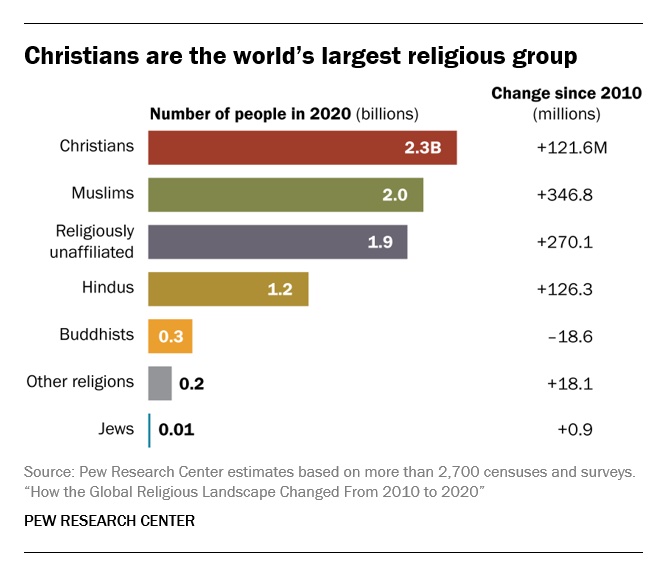
• Muslims are the world’s second-largest religious group (25.6% of the world’s population) and the fastest-growing major religion, largely due to Muslims’ relatively young age structure and high fertility rate. They make up the vast majority of the population in the Middle East-North Africa region. In all other regions, Muslims are a religious minority, including in the Asia-Pacific region (which is home to the greatest number of Muslims).
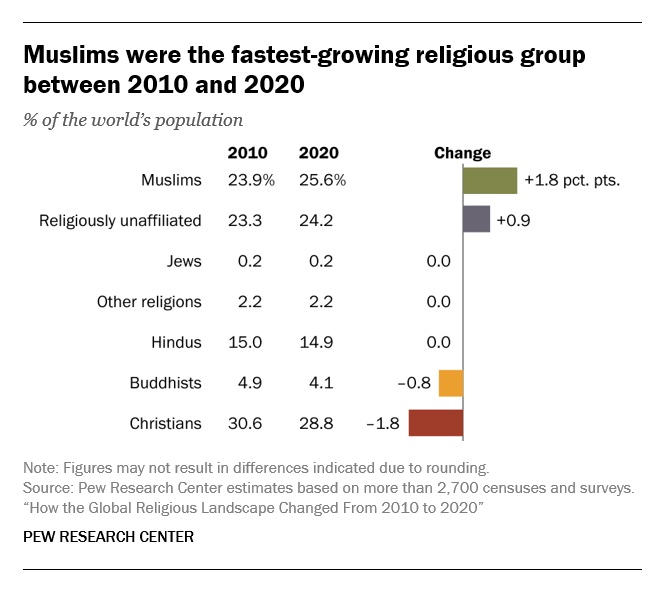
• The religiously unaffiliated population is the world’s third-largest religious category (24.2% of the global population), after Christians and Muslims. Between 2010 and 2020, religiously unaffiliated people grew more than any group except Muslims, despite their demographic disadvantages of an older age structure and relatively low fertility. The unaffiliated made up a majority of the population in 10 countries and territories in 2020, up from seven a decade earlier.
• Hindus are the fourth-largest religious category (14.9% of the world’s population), after Christians, Muslims and religiously unaffiliated people. Most (99%) live in the Asia-Pacific region; 95% of all Hindus live in India alone. Between 2010 and 2020, Hindus remained a stable share of the world’s population because their fertility resembles the global average, and surveys indicate that switching out of or into Hinduism is rare.
• Buddhists (4.1% of the world’s population) are the only group in this report whose number declined worldwide between 2010 and 2020. This was due both to religious disaffiliation among Buddhists in East Asia and to a relatively low birth rate among Buddhists, who tend to live in countries with older populations. Most of the world’s Buddhists (98%) reside in the Asia-Pacific region, the birthplace of Buddhism.
• Jews, the smallest religious group analyzed separately in this report (0.2% of the world’s population), lagged behind global population growth between 2010 and 2020 – despite having fertility rates on par with the global average – due to their older age structure. Most Jews live either in North America (primarily in the United States) or in the Middle East-North Africa region (almost exclusively in Israel).
These are among the key findings of a Pew Research Center analysis of more than 2,700 censuses and surveys, including census data releases that were delayed due to the coronavirus pandemic. This report is part of the Pew-Templeton Global Religious Futures project, which analyzes global religious change and its impact on societies around the world. Funding for the Global Religious Futures project comes from The Pew Charitable Trusts and the John Templeton Foundation.
Uncategorized
Antisemitism in some unlikely places in America

By HENRY SREBRNIK Antisemitism flourishes in a place where few might expect to confront it – medical schools and among doctors. It affects Jews, I think, more emotionally than Judeophobia in other fields.
Medicine has long been a Jewish profession with a history going back centuries. We all know the jokes about “my son – now also my daughter – the doctor.” Physicians take the Hippocratic Oath to heal the sick, regardless of their ethnicity or religion. When we are ill doctors often become the people who save us from debilitating illness and even death. So this is all the more shocking.
Yes, in earlier periods there were medical schools with quotas and hospitals who refused or limited the number of Jews they allowed to be affiliated with them. It’s why we built Jewish hospitals and practices. And of course, we all shudder at the history of Nazi doctors and euthanasia in Germany and in the concentration camps of Europe. But all this – so we thought – was a thing of a dark past. Yet now it has made a comeback, along with many other horrors we assume might never reappear.
Since the Hamas attack on Israel on October 7, 2023, there has been a resurgence of antisemitism, also noticeable in the world of healthcare. This is not just a Canadian issue. Two articles on the Jewish website Tablet, published Nov. 21, 2023, and May 18, 2025, spoke to this problem in American medicine as well, referencing a study by Ian Kingsbury and Jay P. Greene of Do No Harm, a health care advocacy group, based on data amassed by the organization Stop Antisemitism. They identified a wave of open Jew-hatred by medical professionals, medical schools, and professional associations, often driven by foreign-trained doctors importing the Jew-hatred of their native countries, suggesting “that a field entrusted with healing is becoming a licensed purveyor of hatred.”
Activists from Doctors Against Genocide, American Palestinian Women’s Association, and CODEPINK held a demonstration calling for an immediate cease-fire in Gaza at the Hart Senate Office Building in Washington, D.C., Nov. 16, 2023, almost as soon as the war began. A doctor in Tampa took to social media to post a Palestinian flag with the caption “about time!!!” The medical director of a cancer centre in Dearborn, Michigan, posted on social media: “What a beautiful morning. What a beautiful day.” Even in New York, a physician commented on Instagram that “Zionist settlers” got “a taste of their own medicine.” A Boston-based dentist was filmed ripping down posters of Israeli victims and a professor at the University of Pennsylvania Perelman School of Medicine did the same. Almost three-quarters of American medical associations felt the need to speak out on the war in Ukraine but almost three-quarters had nothing to say about the war in Israel.
Antisemitism in academic medical centres is fostering noxious environments which deprive Jewish healthcare professionals of their civil right to work in spaces free from discrimination and hate, according to a study by the Data & Analytics Department of StandWithUs, an international, non-partisan education organization that supports Israel and fights antisemitism.
“Academia today is increasingly cultivating an environment which is hostile to Jews, as well as members of other religious and ethnic groups,” StandWithUs director of data and analytics, and study co-author, Alexandra Fishman, said on May 5 in a press release. “Academic institutions should be upholding the integrity of scholarship, prioritizing civil discourse, rather than allowing bias or personal agendas to guide academic culture.”
The study, “Antisemitism in American Healthcare: The Role of Workplace Environment,” included survey data showing that 62.8 per cent of Jewish healthcare professionals employed by campus-based medical centres reported experiencing antisemitism, a far higher rate than those working in private practice and community hospitals. Fueling the rise in hate, it added, were repeated failures of DEI (diversity, equity, and inclusion) initiatives to educate workers about antisemitism, increasing, the report said, the likelihood of antisemitic activity.
“When administrators and colleagues understand what antisemitism looks like, it clearly correlates with less antisemitism in the workplace,” co-author and Yeshiva University professor Dr. Charles Auerbach reported. “Recognition is a powerful tool — institutions that foster awareness create safer, more inclusive environments for everyone.”
Last December, the Data & Analytics Department also published a study which found that nearly 40 per cent of Jewish American health-care professionals have encountered antisemitism in the workplace, either as witnesses or victims. The study included a survey of 645 Jewish health workers, a substantial number of whom said they were subject to “social and professional isolation.” The problem left more than one quarter of the survey cohort, 26.4 per cent, “feeling unsafe or threatened.”
The official journal of the Alliance for Academic Internal Medicine concurs. According to “The Moral Imperative of Countering Antisemitism in US Medicine – A Way Forward,” by Hedy S. Wald and Steven Roth, published in the October 2024 issue of the American Journal of Medicine, increased antisemitism in the United States has created a hostile learning and practice environment in medical settings. This includes instances of antisemitic behaviour and the use of antisemitic symbols at medical school commencements.
Examples of its impact upon medicine include medical students’ social media postings claiming that Jews wield disproportionate power, antisemitic slogans at the University of California, Los Angeles (UCLA) David Geffen School of Medicine, antisemitic graffiti at the University of California, San Francisco (UCSF) Cancer Centre, Jewish medical students’ exposure to demonization of Israel diatribes and rationalizing terrorism; and faculty, including a professor of medicine at UCSF, posting antisemitic tropes and derogatory comments about Jewish health care professionals. Jewish medical students’ fears of retribution, should they speak out, have been reported. “Our recent unpublished survey of Jewish physicians and trainees demonstrated a twofold increase from 40% to 88% for those who experienced antisemitism prior to vs after October 7,” they stated.
In some schools, Jewish faculty are speaking out. In February, the Jewish Faculty Resilience Group at UCLA accused the institution in an open letter of “ignoring” antisemitism at the School of Medicine, charging that its indifference to the matter “continues to encourage more antisemitism.” It added that discrimination at the medical school has caused demonstrable harm to Jewish students and faculty. Student clubs, it said, are denied recognition for arbitrary reasons; Jewish faculty whose ethnic backgrounds were previously unknown are purged from the payrolls upon being identified as Jews; and anyone who refuses to participate in anti-Zionist events is “intimidated” and pressured.
Given these findings, many American physicians are worried not only as Jewish doctors and professionals, but for Jewish patients who are more than ever concerned with whom they’re meeting. Can we really conceive of a future where you’re not sure if “the doctor will hate you now?”
Henry Srebrnik is a professor of political science at the University of Prince Edward Island.
Uncategorized
The 2025 Toronto Walk (and talk ) for Israel
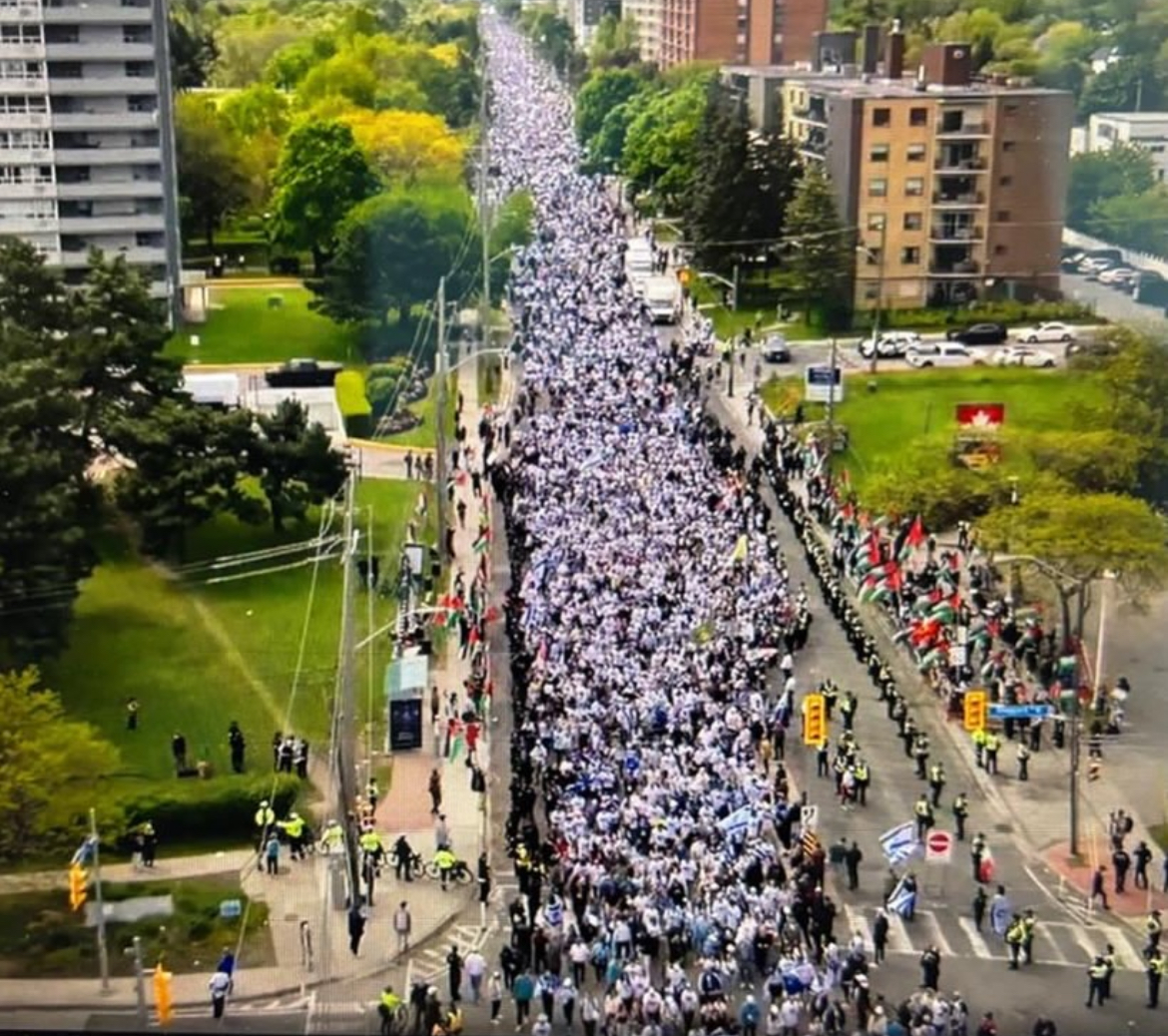
By GERRY POSNER There are walks and then there are walks. The Toronto UJA Walk for Israel on May 25, 2025 was one of a kind, at least as far as Canada and Jews are concerned. The number of people present was estimated to be 56,000 people or 112,000 total shoes. (How they get to that number is bewildering to me, since there is no one counting). This was 6,000 more than last year. Whether it is true or not, take it from me, it was packed. The synagogues in Canada should be so fortunate to get those numbers in total on High Holidays. The picture here gives you a sense of the size of the crowd.
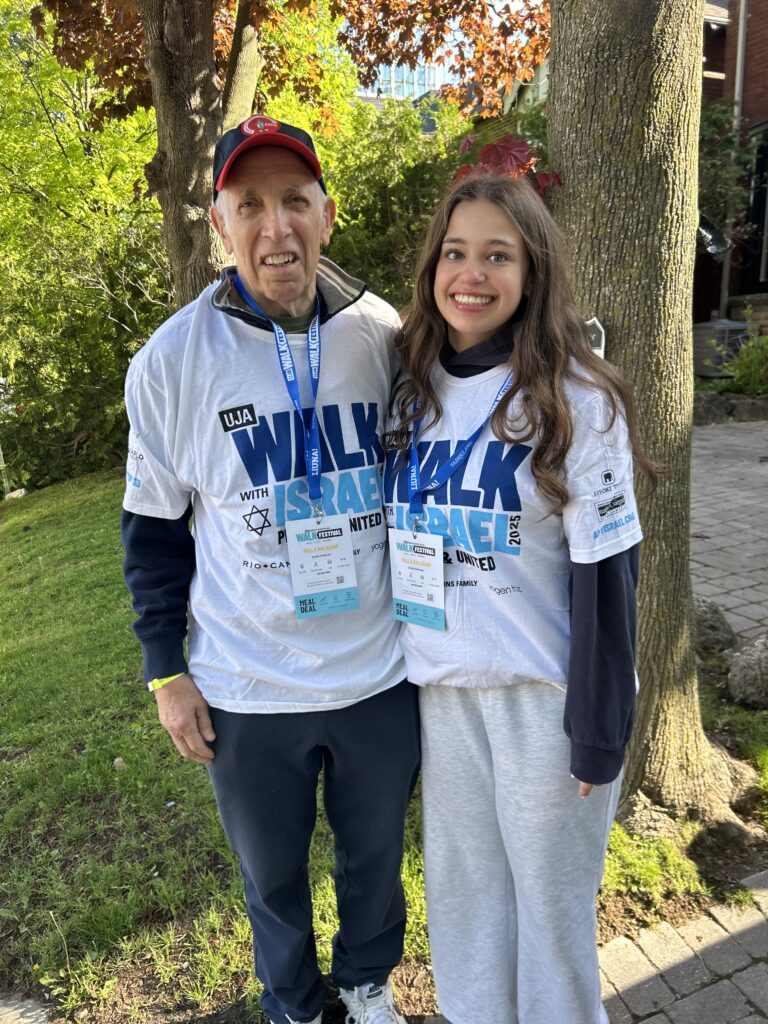
This was my first walk in Toronto for Israel and I was with my granddaughter, Samantha Pyzer (not to forget her two friends whom she managed to meet at the site, no small feat, even with iPhones as aids). The official proceedings began at 9:00 a.m. and the walk at 10:00 a.m. There was entertainment to begin with, also along the way, and at the finish as well. The finish line this year was the Prosserman Centre or the JCC as it often called. The walk itself was perhaps 4 kilometres – not very long, but the walking was slow, especially at the beginning. There were lots of strollers, even baby carriages, though I did not see any wheelchairs. All ages participated on this walk. I figured, based on what I could see on the faces of people all around me that, although I was not the oldest one on the walk, I bet I made the top 100 – more likely the top 20.
What was a highlight for me was the number of Winnipeggers I met, both past and present. Connecting with them seemed to be much like a fluke. No doubt, I missed la lot of them, but I saw, in no particular order (I could not recall the order if my life depended on it): Alta Sigesmund, (who was, a long time ago, my daughter Amira’s teacher), Marni Samphir, Karla Berbrayer and her husband Dr. Allan Kraut and family. Then, when Samantha and I made it to the end and sat down to eat, I struck up a conversation with a woman unknown to me and as we chatted, she confirmed her former Winnipeg status as a sister-in- law to David Devere, as in Betty Shwemer, the sister of Cecile Devere. I also chanced upon Terri Cherniack, only because I paused for a moment and she spotted me. As we closed in near the finish, I met ( hey were on their way back), Earl and Suzanne Golden and son Matthew, as well as Daniel Glazerman. That stop caused me to lose my granddaughter and her pals. Try finding them amid the noise and size of the crowd – but I pulled it off.
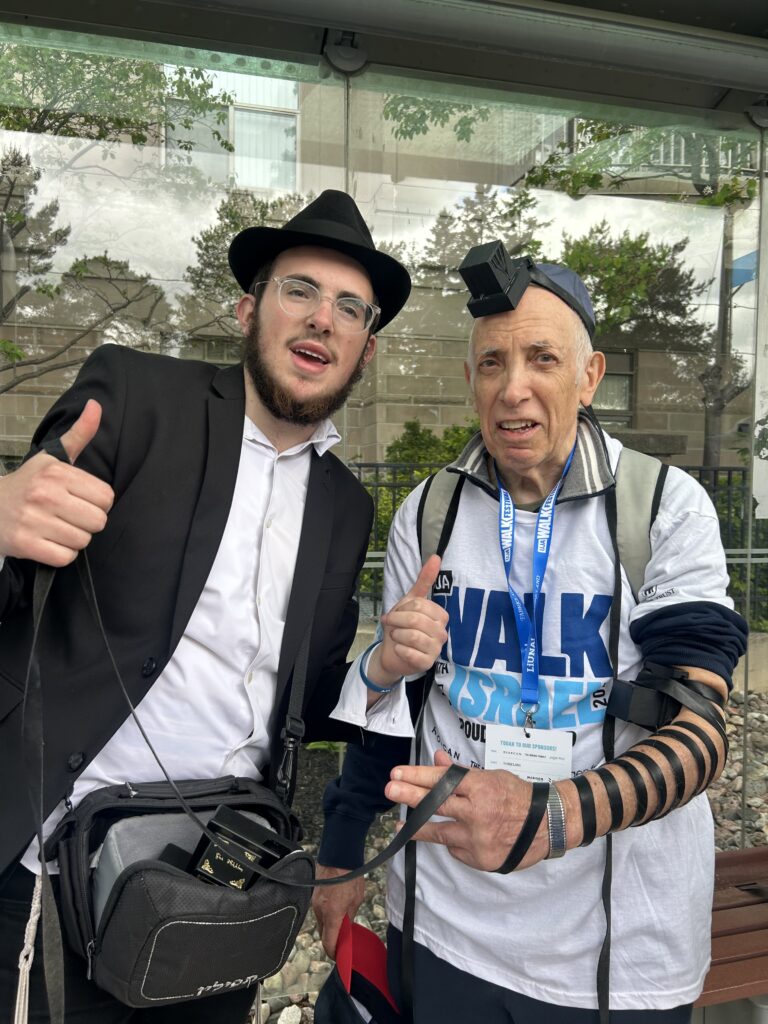
As I was in line to get food, I started chatting with a guy in the vicinity of my age. I dropped the Winnipeg link and the floodgates opened with “ Did I know Jack and Joanie Rusen?” So that was an interesting few minutes. And I was not too terribly surprised to come across some of my Pickleball family. All of these meetings, along with spotting some of my sister’s family and other cousins, were carried on with the sound of the shofar as we moved along the way. In short, this was a happening. Merchants selling a variety of products, many of them Israeli based, were in evidence and, of course, the day could not have ended without the laying of tefillin, aided by Chabad, who have perfected the procedure to take less than a minute. See the photo. Chabad had a willing audience.
Aside from the joy of sharing this experience with my granddaughter, the very presence of all these Jews gathered together for a common reason made this day very special to me. However, there was a downside to the day. The downside was that, as we began to walk back to our car there was no other way I could figure out how to return when the rains came and came. While we walked faster, we were impeded by pouring rain and puddles. But Samantha wanted to persevere, as did I. We made it, but were drenched. My runners are still drying out as I write this two days later.
What with being surrounded by 56,000 people, the noise, the slow walking, and the rain, I can still say the day was a real highlight for me – one of the better moments since our arrival in Toronto in 2012. As well as the photos we took along the way, I have the reminder of the day, courtesy of the UJA, as evidenced from the photo. It was not just the walk, but the talk that accompanied the walk that made it so worthwhile for me. I would do it again, minus the rain.
